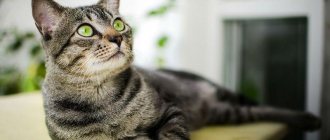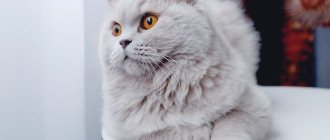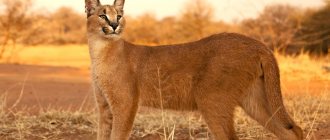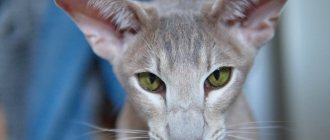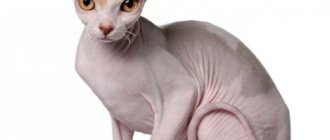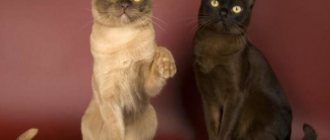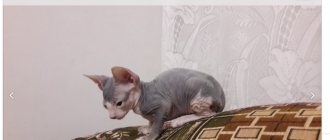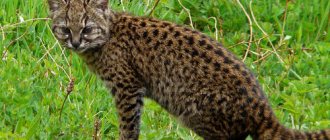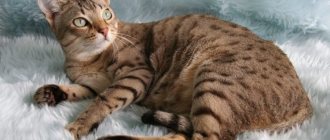The Chinese cat is a direct descendant of wild cats that lived in the mountains of northwestern China and southern Mongolia. Perhaps that is why they look so much like outbred yard animals. There are no official nurseries of this breed in Russia, although there are more and more people wanting to buy kittens.
Let's find out why huas are so good that their true connoisseurs are willing to pay more than $1,000 for an individual.
Brief history of the breed
The first mentions of the Chinese cat are found in documents dating back to the reign of the Tang Dynasty (Tibet).
Residents of the Middle Kingdom call li hua “dragon li” or “fox flower cat.”
In 2003, Chinese cats took part in an exhibition for the first time, which was held in Beijing. A cat named Nedy then received the champion title. In the same year, two representatives of the breed, a female and a male, were taken from China to the United States for the purpose of breeding.
The standard was developed over 2 years and approved in 2005, and the Chinese breed received official recognition in 2010.
Appearance and breed characteristics
The Gobi gray cat lives in China, which determines the second name of the representatives of the breed. Natural habitat is mountainous areas, steppes and forests.
Poaching, expanding agricultural activity leading to food shortages, and large dangerous predators are the main reasons that led to a multiple decline in the population. Today, this unique breed is on the verge of extinction, and therefore is included in the Red Book.
The Gobi gray cat is distinguished by its muscularity and large build. The average height of adult individuals is about 100 cm, the weight category varies from 4 to 9 kg.
The Chinese cat has a large head , large ears with specific tufts at the ends, and a powerful and thick fluffy tail . The animals have very beautiful, long thick hair with a pronounced undercoat. It was the luxurious, shiny fur that was the reason for the hunting, which led to a sharp reduction in the number of Chinese cats.
color changes depending on the time of year. So, in the summer months the fur has a grayish-yellow tint, and in winter it becomes darker with a predominance of brown tones. Against this background, the large and expressive emerald-colored eyes .
The tip of the tail is black. The coat of the Gobi gray cat has spots and stripes that do not stand out too much. Thanks to this color, the Chinese cat has the ability to easily camouflage itself in natural conditions.
The thick undercoat protects the animal from wind and cold, and its muscular, strong paws help it quickly run away from enemies and break holes in search of food. Like many other predators, the Chinese cat has excellent hearing and excellent sharp vision.
Interesting Facts
Interesting information about the breed will help you get to know the dragon better:
- These animals are distinguished by their independent character, but show exceptional devotion to their owner.
- Chinese cats are smart and can be trained. One famous person from China trained his pets to bring him newspapers.
- In China, these animals are sometimes taken to wedding ceremonies.
- Chinese cats grow very slowly, so breeders do not give away kittens at an early age, but wait until they are stronger.
- The Chinese believe that li hua can protect the home from evil spirits.
How did the fate of the Chinese (mountain) cat unfold?
These unique animals began to attract the close attention of naturalists only at the end of the 19th century, when China opened entry to foreigners. At the same time, the French missionary Felix Bie first gave a detailed description of the species, and later these wild cats were given the name in honor of the scientist - Felis bieti.
Chinese mountain cats have a history dating back thousands of years.
Chinese mountain cats were once distributed throughout China and even in Mongolia. But regular trapping of animals for the use of skins as decoration for traditional clothing has led to a decrease in the number of the species. And the beginning of the use of chemical poisons in the fight against rodents has brought the endemic species of these animals to the brink of extinction.
By the 60s. In the 20th century, already secretive animals began to be seen less frequently, and interest in their study became stronger. And by 1973, about 30 different-sex individuals were settled in one of the Chinese zoos, which provided a constant opportunity to observe them.
Scientists could not decide on a name for Chinese mountain cats until 1992. The Han people themselves call the predators with the inconspicuous phrase huang mo mao, which translates as “a cat that lives in the desert with sparse vegetation.” Moreover, most often these animals are noticed in the steppes and plateaus rather than among the Gobi dunes. Therefore, in the 1990s, zoologists convened a special commission, as a result of which, along with the name “Gobi Gray Cat,” it was decided to use the name “Chinese Mountain Cat.”
And in 2007, geneticists presented the world with new information that sheds light on the origin of this predator. According to data obtained during a study of mitochondria from the DNA of representatives of the cat family, the cats living in the Chinese mountains separated from the forest cat Felis silvestris as much as 230 thousand years ago. And only after such a statement, Gobi cats were identified as a separate species, changing the classification of these endemics.
Breed description, standards, appearance
The appearance of the Li Hua was influenced by the habitat of their ancestors - wild mountain cats. The climatic conditions on the border of China and Mongolia are quite harsh - in winter and summer the air temperature reaches critical levels, and strong winds constantly blow there. For this reason, Chinese cats' fur has become thick and dense, and fluffy “slippers” have formed on their paws, capable of protecting their pads from the cold.
Externally, the Hua is not much different from wild-colored yard cats. It is slightly larger than its European counterparts, and its body type resembles strong and muscular jungle cats.
Dimensions and weight
The Chinese mountain cat living in the wild is quite large. It reaches 1.4 m in length (including the tail). Domestic cats of this breed are smaller. The height at the withers of an adult cat is 35–38 cm. Females are smaller - their height does not exceed 30 cm. The weight of a male animal is 4.5–5.5 kg. The cat's weight is 3.5–4 kg.
Anatomical characteristics
Chinese cats can boast of a harmonious body composition. Their appearance reveals the power of a predator, which does not fit in with their affectionate disposition.
This is what they should look like:
- elongated body with a wide chest;
- the back is straight;
- the length of the limbs is proportional to the body;
- The Chinese cat has large oval-shaped paws;
- medium-sized head with a large frontal part;
- the muzzle is slightly elongated, but not pointed;
- strong, well-developed chin;
- massive lower jaw with correct bite;
- the bridge of the nose is wide, and the nose is neat, brown in color with a dark outline;
- the calling card of the Chinese cat is its large almond-shaped eyes with raised outer corners;
- the iris is emerald green or golden yellow;
- medium-sized ears with a wide base and rounded tips;
- a long tail with a wide base that gradually tapers towards the end.
Color and coat type
Chinese cats have a spectacular and bright coat color - black brindle tabby. On a brown background there are clear black stripes on the back and sides. There are chaotically scattered dark spots on the stomach. On the limbs and tail of the Chinese cat, the stripes form rings like bracelets. The tip of the tail is colored black, and the paws are a solid light brown.
The chest is decorated with one or more "necklaces". The letter M is clearly visible on the forehead. The eyes are lined with anthracite eyeliner, and spectacular dark lines extend from their outer corners, reminiscent of the contours of a mask. The area around the lips and chin are always highlighted. The nose is brown with a black edging.
Chinese cats have short, very thick hair, but at the same time soft and delicate to the touch. It consists of a guard and a small undercoat. Thanks to this structure, the cover retains heat well and hardly gets wet.
Each hair is ticked, that is, colored in different shades: the lower part is dark, the middle part is light, and the tip is brown.
Interesting. There is a Chinese fold cat in the Middle Kingdom, but it is not recognized by any felinological organization. Although there is documentary evidence that this species was known long before the appearance of the Scottish Fold.
Possible breed defects
Disadvantages in the exterior that will not allow the Chinese cat to receive high marks at the exhibition:
- ears too big;
- non-standard shape and position of the eyes;
- narrow or too wide forehead;
- weak pattern on the coat;
- overweight or underdeveloped muscle corset.
Animals are disqualified due to serious conformation defects. Chinese cats cannot take part in championships and are not used for breeding if they have the following defects:
- creases on the tail;
- malocclusion;
- light nose;
- eye color other than green or yellow;
- polydactyly (extra toes);
- long or sparse hair;
- a color type other than that approved by the standard.
Purchasing a kitten
Purchasing a wild animal with the character of a predator is a responsible decision. The animal needs a large territory and loneliness; individuals, accustomed to living alone in nature, are forced to be in the spotlight and show aggression.
It is especially dangerous to keep a Mountain Cat with other animals. Pets will conflict and can cause irreparable harm to each other. Victory will be on the side of the wild animal, which is stronger and larger than domestic ones.
Breeders need to know that sterilization of the Chinese mountain cat is contraindicated. He does not tolerate anesthesia well and if he survives, his character changes for the worse. Keeping such animals outside the cage is dangerous for the owner.
When purchasing a pair, even experienced breeders take risks. It is impossible to be sure that animals will be able to reproduce in captivity, since the choice of a mate in cats usually occurs during the breeding season. During the rut, animals that have not found a mate become aggressive towards their own kind, and at home they can attack the owner, perceiving him as a rival.
There is no question of the Mountain Cat living in an apartment. This is deliberate murder. Living in a closed space leads to illness and death of the pet. It is impossible to toilet train an animal; it will mark its territory no matter what, as this happens in nature.
Considering the characteristics of the animal, it is better to leave it to live in nature or, in extreme cases, in a reserve or zoo with excellent conditions and competent specialists. For the home, it is recommended to purchase artificially bred breeds adapted for small spaces and constant contact with humans.
Character and temperament
Chinese cats will never spend days on end on their owner's lap. They are unobtrusive and independent. When no one is home, the pet will find something to do with itself.
The main thing is that he has a lot of toys at his disposal and a place where he can frolic. Chinese cats love to climb, run and jump.
Despite their independence, they know how to show love and tenderness. Although they are not happy with small children. Chinese cats do not like to be cuddled or have their tail pulled.
If a child repeatedly hurts a pet, the pet will prefer to avoid the baby. Li Hua may even extend its claws as a warning of an attack, but such cases are rare.
Chinese cats are unsurpassed hunters. Catching a fly or butterfly is not difficult for them. Small pets such as hamsters, rats and parrots are also at risk. Keeping a mountain cat together with them is not allowed.
Chinese cats are very attached to their home and therefore have a hard time with changing their place of residence. It is unlikely that you will be able to travel around the world with such a pet.
Character and behavioral characteristics of the Chinese cat Dragon Li
Li Hua cats are distinguished by their independence and independent disposition . They love affection, but they will not sit all day long on their master’s lap. These are calm and patient animals, they love to run and play, they are devoted to their owner, but in his absence they do not get bored at all. They must be provided with enough space for free movement and outdoor games; in small rooms the descendants of wild mountain cats are extremely uncomfortable.
Chinese Li Hua cats have a calm and independent character.
In order for your Li Hua cat to have a place to frolic, you need to purchase or make your own multifunctional play complex, which will include beds, houses, ladders, tunnels, scratching posts, scratchers, scratchers, toys and other interesting devices.
Like all cats, Li Huas are extremely inquisitive, or rather, curious. They will definitely come out to look at the guests, but only from afar, since the breed is not known for its gullibility. The excellent hunting qualities of pets of Chinese origin have been noted; there will never be rats, mice or even flies in the house. For this reason, it is not recommended to keep birds, hamsters and other small animals, which mustachioed hunters always perceive as prey.
Chinese cats tolerate small children steadfastly, but not for long. They may well use their teeth and claws if they feel violence against their own personality. Although they get along peacefully with other cats and dogs. Pets get very used to the house, do not tolerate moving well and have difficulty adapting to new premises. Li Huas are endowed with extraordinary intellectual abilities, are easy to train, and can also perform simple commands and tricks.
Chinese cats can be trained to fetch various items
While searching for information on Chinese cats, I discovered a historical fact that a certain well-known political figure in China - the revolutionary Zhao Shangcai - trained his own cats to carry newspapers for him.
Video: dragon li cat playing
How to choose the right kitten
Buying a Chinese Li Hua cat is quite difficult, because it is found only in its homeland and in the USA. Even in China it is not widespread, there are only a few nurseries there. Prices for kittens start at $1,000, and the cost of shipping the animal also falls on the buyer.
When choosing a Li Hua, you need to be very careful, because the breed is similar to an ordinary yard cat. You cannot trust sellers who post advertisements for sale on virtual bulletin boards - most often they are scammers. They do not have documents confirming their pedigree or vaccination certificates.
Those who have agreed to purchase a Chinese cat from a breeder from China or America need to make sure that the pet matches the description of the breed and is absolutely healthy. This can be judged by the following signs:
- the cat is active, playful, makes contact;
- he has clean eyes and ears;
- he is moderately well-fed;
- there are no bald spots on the body;
- the abdomen is soft, without signs of bloating.
Kitten care
Chinese kittens should not be separated from their mother before 12 weeks of age. Some breeders do not release them to new owners until 4 months. By this time, the babies are already accustomed to the tray and scratching post, and can eat from a bowl independently.
They can be fed with chopped lean chicken, turkey, veal, rabbit with the addition of vegetables. Also included in the kittens’ diet is low-fat cottage cheese, boiled eggs, and cereals.
Motor activity is very important for harmonious development. A cat needs a lot of space to run and play. Caring for her includes regular cleaning of her eyes and ears, combing her fur and shortening her nails.
Character of the Chinese cat Li Hua
The character of this animal with dragon eyes is distinguished by independence and strength, but at the same time, the Dragon Li cat is very calm.
These pets are moderately active and curious, but they show a remarkable love of freedom. Since the variety’s roots go back to mountain wild cats, Li Hua are considered unsurpassed hunters and will very quickly rid the home of rats and mice. This should be taken into account by those families who already have pets of this kind: mice, hamsters, guinea pigs or birds. All these cute “neighbors” could seriously suffer from the claws and teeth of Li Mao. Although there is not too much aggressiveness towards them, anything can happen. Important! These cats really do not like moving, and it takes them quite a long time to adapt to their new place of residence. The animal is very social and attached to its owners, so if your work involves moving or long absences, then this pet is not for you. It is necessary to pay attention to the cat several times a day.
Cats of the Li Hua breed are very loyal, although they are tolerant of children, they still may not be able to withstand their pranks and use their claws, so it is better to have such an animal for a family without children. They can also get along with other pets, such as dogs or cats of other breeds. If the owner lives in a small apartment, then there will not be enough space for Dragon Li; it is preferable to keep him in a private house due to his activity in games.
Many owners of cats of the Li Hua breed note the increased intelligence of their charge. It is easy to accustom him to a scratching post, since due to his wild ancestors they simply love to sharpen their claws on everything they see. To avoid these problems and damage to property, it is better to immediately show the cat the device that he is allowed to “shred.” But usually, if the cat is not left alone for a long time, he will not do anything bad. When guests come to the house, this animal will not allow itself to be squeezed, although it will not run away from strangers.
Care and maintenance
To keep a Chinese cat you need a large apartment or house. It’s good if you have your own garden nearby so that your pet can frolic in the fresh air. To prevent the animal from escaping through the fence, an Antikot system is installed on the fence.
The owner of a Chinese cat will not have to spend a lot of time on care:
- The coat must be combed every 2-3 days. You will need a slicker brush to process the undercoat. During seasonal molting, the procedure should be performed more often.
- A Chinese cat is bathed no more than 3-4 times a year. A shampoo that does not cause irritation or allergies is suitable for washing wool.
- The eyes are wiped every day with a moistened sponge.
- The claws of a Chinese cat are trimmed 2 times a month. It is convenient to do this with a nail clipper.
- It is advisable to examine the ears once a week. If there is a lot of sulfur inside, then it must be removed using a cotton pad soaked in a special lotion or hydrogen peroxide.
If a brown mass has formed in the ears, and the cat has become restless and shakes its head frequently, you need to take it to the veterinarian. Such symptoms occur with otodectosis, a disease caused by ear mites.
Features of keeping and caring for Chinese cats
There are no special worries in the maintenance of Li Hua.
Nutrition
Chinese Li Huas eat both commercially prepared (dry and wet) food and natural food with equal pleasure. Prepared food must be at least premium class (preferably higher). For example:
- Royal Canin FIT 32;
- Orijen Cat & Kitten Grain Free;
- Acana Regionals Grasslands Cat Grain-Free;
- Applaws Adult Cat Chicken Grain Free;
- Hill's Nature's Best.
1st Choice Adult dry food is an ideal formula for indoor cats with special carefully selected ingredients
A natural diet should consist of:
- beef or veal meat (frozen);
- boiled offal (heart, lungs, etc.);
- hare, rabbit, turkey, chicken;
- boiled sea fish (without bones);
- fresh and boiled vegetables (carrots, zucchini, cabbage, spinach, turnips, etc.);
- eggs (preferably quail);
- cereals (buckwheat, barley, etc.);
- low-fat fermented milk (kefir, cottage cheese, unsweetened yogurt, etc.).
When feeding natural food, pets should be given vitamin and mineral supplements.
Gimpet Kase-Rollis cheese balls with multivitamin for cats - a new product from the German company Gimpet combines three functions: a delicious treat with mascarpone cheese, an exciting game for cats and a functional food supplement with vitamins
Adult animals are fed twice a day (morning and evening). The serving size per meal is calculated from the ratio of 35–40 g (natural food) or 17–20 g (freeze-dried food and canned food) per 1 kg of pet’s live weight. Kittens are fed 4–5 times a day (after 6 months three times), the daily norm is about 200–250 g.
Any cat is prohibited from being given smoked, peppered, spicy, spicy and sweet foods, as well as pork, legumes, river fish and citrus fruits.
Necessary living conditions
The Chinese cat needs to be provided with a comfortable and cozy sleeping place (bed, basket, house), as well as a couple of bowls for food and fresh water. A prerequisite is the presence of a vertical, firmly fixed scratching post (preferably several), otherwise the situation in the house may suffer.
You can find special scratching posts on sale
All cats love to survey the territory under their control from the highest vantage point possible. Our cat constantly climbs onto the refrigerator, because from there she can see almost everything that happens in the house. Experienced cat owners recommend attaching several shelves to the walls so that the pet can lie there and carefully observe everything.
Hygiene measures
Caring for a li how is very simple. Need to:
- Once every 3-4 weeks, cut off the tips of the claws by 1-2 mm, being careful not to touch a blood vessel. There are special protective caps that are placed on the claws of the front paws and fixed with glue. The covers fall off on their own as the horny plate grows. But anti-scratch pads cause certain inconvenience to cats, as they interfere with scratching, climbing on vertical surfaces and prevent their claws from being fully retracted.
To prevent the cat from tearing furniture and wallpaper, anti-scratch guards are placed on its claws.
- Wipe your eyes daily with special veterinary compounds (Cliny C, Nature SaniPet). If they are not available, you can use tea leaves, herbal decoction (chamomile, marigold, etc.) or warm boiled water.
- Once every 10–15 days, clean the ears with a cotton swab dipped in hydrogen peroxide, chlorhexidine or a special product (ABZ Bars, Hartz, etc.).
- Brush the coat with a special rubber brush or mitten once a week. During heavy molting, this is done daily.
- Bath no more than 1-2 times a year. After the procedure, it is recommended to thoroughly dry the cat with a towel and dry its fur with a hairdryer so that it does not catch a cold. It is better to wash with special shampoos: Bio-Groom Silky Cat Shampoo;
- Espree Shine of silk;
- Ms.Kiss Graceful Panther;
- Perfect Coat;
- Ecoprom CLINY;
- Gamma.
Veterinarians advise cleaning your cat’s teeth every 5–7 days using a special toothpaste and brush.
Photo gallery: shampoos for Chinese cats
Bio-Groom Silky Cat Shampoo - shampoo-conditioner for cats is developed on the basis of unripe coconut oil, which moisturizes the coat and gives it extra shine and silkiness Shampoo Shine of Silk gently cleanses, moisturizes and gives the coat a healthy and well-groomed appearance Ms.Kiss Shampoo Graceful Panther for short-haired cats, developed on the basis of the latest Swiss technology, provides shine, tight fit, straightening, elasticity and smoothness of the cat's coat Perfect Coat - shampoo + conditioner, con for kittens and cats Gamma Shampoo for smooth-haired cats contains high-quality detergent ingredients, conditioning additives, group vitamins A, B, E, natural waxes obtained from pine and pine needles Cliny shampoo for kittens is created for gentle care of the skin and hair.
Feeding a Chinese cat
Experienced breeders recommend feeding Chinese cats premium ready-made industrial formulas. They already contain everything necessary for health and proper development - protein, vitamins, minerals.
Those who prefer to create their own diet for their pet should include in the Chinese cat’s menu:
- frozen lean meat;
- sea fish;
- cereals – oatmeal, rice;
- fermented milk products - classic yogurt, yogurt, sour cream;
- vegetables - carrots, broccoli, spinach.
Chinese cats should not be fed bones, sausages, sausages, salty, spicy foods, sweets and baked goods, as well as potatoes. Pork and lard are also strictly prohibited.
Education and physical activity
Chinese cats are very smart and easily learn to use a litter tray and scratching post. If desired, your pet can be taught to perform simple tricks. When raising a cat, you need to be patient; you cannot shout at him or use force. If you motivate your pet with treats, you can achieve good results in training.
Chinese cats are naturally highly active. You will have to walk your Li Hua regularly to keep her in good shape. If the owner does not have the opportunity to often go outside with the cat, then a play complex of 2-3 tiers with ladders and tunnels should be installed in the house. It would be good if it had a running wheel.
Is it possible to keep in captivity?
As animals officially listed in the Red Book, Chinese cats cannot be kept as pets at home. Representatives of this rare breed live in nature reserves and zoo corners.
It is not difficult to purchase a baby Gobi gray cat on the illegal market for a lot of money. But potential owners must understand that it will be quite difficult for such a wild animal to provide all the necessary conditions, without which it will soon begin to get sick, wither and, as a result, simply die.
Health and susceptibility to disease
Puberty in Chinese cats occurs at the age of 8–9 months. However, you should wait until at least 1.5 years for the first mating. Early pregnancy can result in miscarriage or undermine the health of the mother cat.
Li Hua has good health, since this breed has never been infused with other blood and was not created artificially. No hereditary diseases were found in its representatives. The average lifespan of a Chinese cat is 15–18 years.
Price and purchase of a kitten of the Chinese breed Li Hua
Since this variety of the cat world is quite rare and its acquisition is very problematic, which accordingly affected the price of the animal.
And because of its ordinary appearance and high cost, despite its advanced age, the breed never became widely popular. The number of Chinese nurseries engaged in breeding Dragon Li cats can be counted on one hand; there are several animals in the USA, but there are practically no breeders represented. Therefore, if you want to have a Li Hua kitten with dragon eyes, you will have to pay about 200 USD. e. (sometimes the figure is 30,000 rubles), and delivery from the Chinese breeder will be your responsibility. But they say that although it is possible to purchase such a pet outside of China, the price will increase several times.
Video about a cat of the Li Hua or Dragon Li breed:
Photos of Li Hua:
Vaccinations and antiparasitic treatment
To maintain health, your Chinese cat should be vaccinated against infectious diseases in a timely manner. The first vaccination is carried out at the age of 3–4 months, repeated ones are done once a year.
Kittens must be vaccinated against the following diseases:
- rabies;
- calcivirosis;
- panleukopenia (distemper);
- chlamydia.
Vaccinations are given only to healthy cats. Deworming is carried out first. Chinese cats that are outdoors must undergo therapeutic and preventative treatment for fleas and other skin parasites.
Pros and cons of the breed
Many breeders dream of a Chinese cat, but before deciding to buy an animal, it is worth analyzing its positive and negative sides.
| pros | Minuses |
| Unpretentiousness, ease of care | Low prevalence |
| Undemanding to the food supply | High cost of the animal |
| Spectacular appearance | Problems finding a mating partner |
| Good health | Does not tolerate change of residence well |
| Well developed hunting instinct | |
| High intelligence | |
| Friendly disposition |
The Chinese Li Hua cat breed is undoubtedly worthy of attention. There are more and more connoisseurs of it, but so far it is not available to everyone. The high cost of kittens is due to the small distribution of the breed, and not to any outstanding qualities of the animals.
Perhaps in a few years, Chinese beauties will become more accessible to Russians, and then even more information will appear about them.


